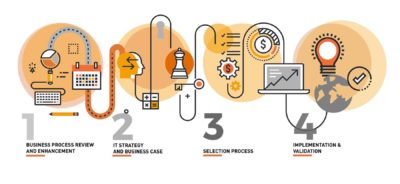Going paperless: where to start with your digital transformation project?
Today life is made of digital activities and interactions all day long. However, our laboratory processes have still a long way to become paperless and take advantage of the benefits in digitalizing the lab processes along the whole data lifecycle. This article provides some guidance on the concept and how to start a digital transformation project efficiently.
From paper to digital – the change
Our daily activities are now based on digital systems. We are reading newspapers, books, articles (like this one), sitting in front of our computer in the office, with a mobile device in our hand in a plane or a train. We don’t need to retrocede several years to find the picture of flight attendants proposing a paper magazine or a newspaper to the travelers.
Two fundamental changes have allowed us to be connected to the many information at any time and virtually in any place. The continuous and frenetic improvements on the capabilities of computers and mobile devices together with the availability of very fast wireless networks.
Capabilities have considerably increased, sizes have considerably been reduced, allowing an incredible step to mobility. Remaining connected while progressing along the production line or reviewing results from remote location are bringing alternatives and opportunities to data management processes that leverage effectiveness, provide instantaneousness.
What was just a dream twenty years ago is now the reality we can touch in any moment of our daily activities.
How digital transformation matters in our business life
What does digital transformation mean in our business life and how much has it affected the way we perform our daily tasks? Even though they are still huge gap between tasks, we are having our agendas mostly stored in a digitized system, we book the hotels, the flights, the rental cars via computers and apps, and most of the related information are provided in electronic formats. Meanwhile, some banks are unable to stop mailing you the very same information that you check easily online from your mobile device.
In this sense, in the era of the industry 4.0, too many laboratories are still following paper-based processes that support their data management, the sharing of the information and communication of the decision.
This is not only because there are some reluctances to introduce digital solutions and remove the paper in the laboratories related industries. This is possibly true in some situations and this will be extensively covered in future articles. One of the reasons why paper is not removed from the benches, is because it is still considered a better proof of good control and a solid demonstration of proper checks.
We practically all pour our thoughts on ink and paper, take notes and sketch ideas. Evidently, some mental processes are still better materialised through a manual drawing on a piece of paper.
How can we introduce a digital transformation project efficiently
First of all, we should work on being confident that the “digital world” is as secure as the “paper world”. Basic informatics concepts are too often assumed to be known by default and no one takes the time to seek for the information and provide it to the key decision makers, stakeholders and final users of such project.
Knowledge and education are the key elements to be considered at this very first stage of the project to drive the change management.
While a digital newspaper is very similar to a newspaper and a digital agenda to a paper-based one, an electronic laboratory notebook (ELN) is sometimes very far from the “old style” notebook we use in the laboratories.
While we quickly accommodate to the interactions that a digital newspaper offers to reach the information of interest and share them into our social media of preference, we also set reminders and benefit efficiently from our digital agenda. So, we adapt ourselves to the new tools. But in what concerns our lab processes we suddenly become extremely reluctant to do it differently.
In proportion of the multiple apps available for your smartphone, the amount of ELN solutions available in the market is considerable. Not all are suitable to your needs.
So, the second point here is to go to the market with very clear definition of your requirements aiming for aligning the tool capabilities to your processes without closing the door to potential improvement adjusting and revisiting such processes in alignment with the tool. There are very strong statements made at this stage where final users require the tool to adapt to their processes and where vendors claim that tool has been designed for you to work in better conditions and you are the one who should adapt your processes to it. As always the truth is half way.
You own your processes and the way the work is done at your department, company. No informatics system should challenge it. However, your processes are not so unique and solution providers have learnt along the way in developing and implementing their solutions. It might be good to remain open to new ways of doing it. Which doesn’t mean challenging the whole approach but maybe incorporate features and abilities that were disregarded before.
in other words, a profound business reengineering of your processes might not be necessary yet taking the time to look at the actual picture and identify the areas for improvement might help to find the tool that precisely supports you in improving your processes: increase efficiency, improve visibility on your team productivity, easier measurement of your KPIs, quicker communication, better control on your data life cycle, higher level of data integrity …




















